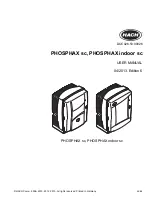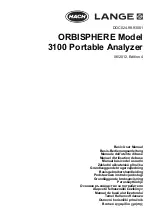
T2000-T2100
EN – 4
2. GENERAL DESCRIPTION
T2000 allows carrying out the following functions:
Resistance measurement on earth rods with resistive loop method
Direct measurement on earth probes without any cable interruption
Measurement of leakage current on earth systems (T2000)
Setting of alarm thresholds on measurements
Storage
of
measurement results
Download to MASTER instrument (by means of RS232 port) of resistance values and all
measurements stored in the instrument’s memory
There are 3 multifunction keys on the instrument. The selected quantity appears on the LCD
display with the indication of the measuring unit and of the enabled functions. The
instrument is also equipped with an Auto Power OFF device which automatically switches
off the instrument approx. 5 minutes after the last time a function key was pressed or the
clamp was opened, and with an LCD backlight to carry out measurements even in poorly
illuminated environments.
2.1. MEASURING
AVERAGE
VALUES AND TRMS VALUES
Measuring instruments of alternating quantities are divided into two big families:
AVERAGE-VALUE meters: instruments measuring the value of the sole wave at
fundamental frequency (50 or 60 Hz)
TRMS (True Root Mean Square) VALUE meters: instruments measuring the TRMS
value of the quantity being tested.
With a perfectly sinusoidal wave, the two families of instruments provide identical results.
With distorted waves, instead, the readings shall differ. Average-value meters provide the
RMS value of the sole fundamental wave; TRSM meters, instead, provide the RMS value of
the whole wave, including harmonics (within the instrument’s bandwidth). Therefore, by
measuring the same quantity with instruments from both families, the values obtained are
identical only if the wave is perfectly sinusoidal. In case it is distorted, TRMS meters shall
provide higher values than the values read by average-value meters.
2.2. DEFINITION OF TRUE ROOT MEAN SQUARE VALUE AND CREST FACTOR
The root mean square value of current is defined as follows: “In a time equal to a period, an
alternating current with a root mean square value with an intensity of 1A, circulating on a
resistor, dissipates the same energy that, during the same time, would have been dissipated
by a direct current with an intensity of 1A”. This definition results in the numeric expression:
G=
T
t
t
dt
t
g
T
0
0
)
(
1
2
The root mean square value is indicated with the acronym RMS.
The Crest Factor is defined as the relationship between the Peak Value of a signal and its
RMS value: CF (G)=
RMS
p
G
G
This value changes with the signal waveform, for a purely
sinusoidal wave it is
2
=1.41. In case of distortion, the Crest Factor takes higher values as
wave distortion increases.






































